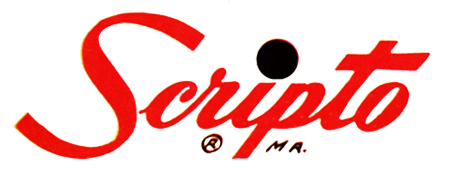Scripto Long Writing Pen c. 1947–48
by Jim Mamoulides, February 13, 2023
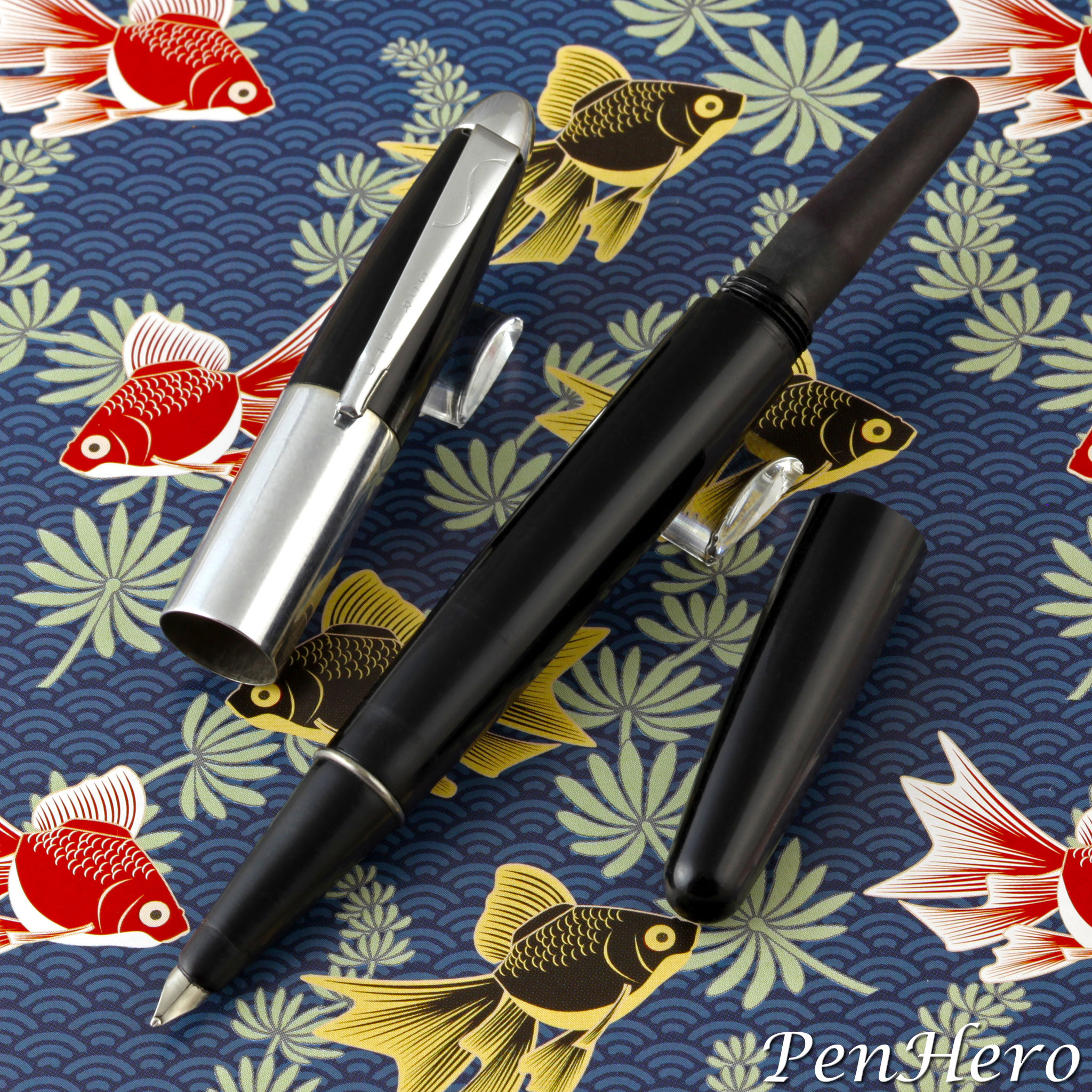 Scripto Long Writing Pen in lustrous black c. 1947-48
Scripto Long Writing Pen in lustrous black c. 1947-48
Scripto Enters the Fountain Pen Field
Scripto, Inc., the Atlanta, Georgia based and self-proclaimed world's largest manufacturer of mechanical writing instruments had a very interesting 1947. First there was a change in leadership with James V. Carmichael being promoted to President of the company on May 1, 1947, after a short stint as Executive Vice President. He previously was Vice President and manager of Bell Aircraft Corporation's largest manufacturing plant in Marietta, Georgia during World War II which built B-29 Superfortress bombers and then shut down after the war ended. He also made an unsuccessful bid for the 1946 Democratic Party nomination for governor of Georgia.
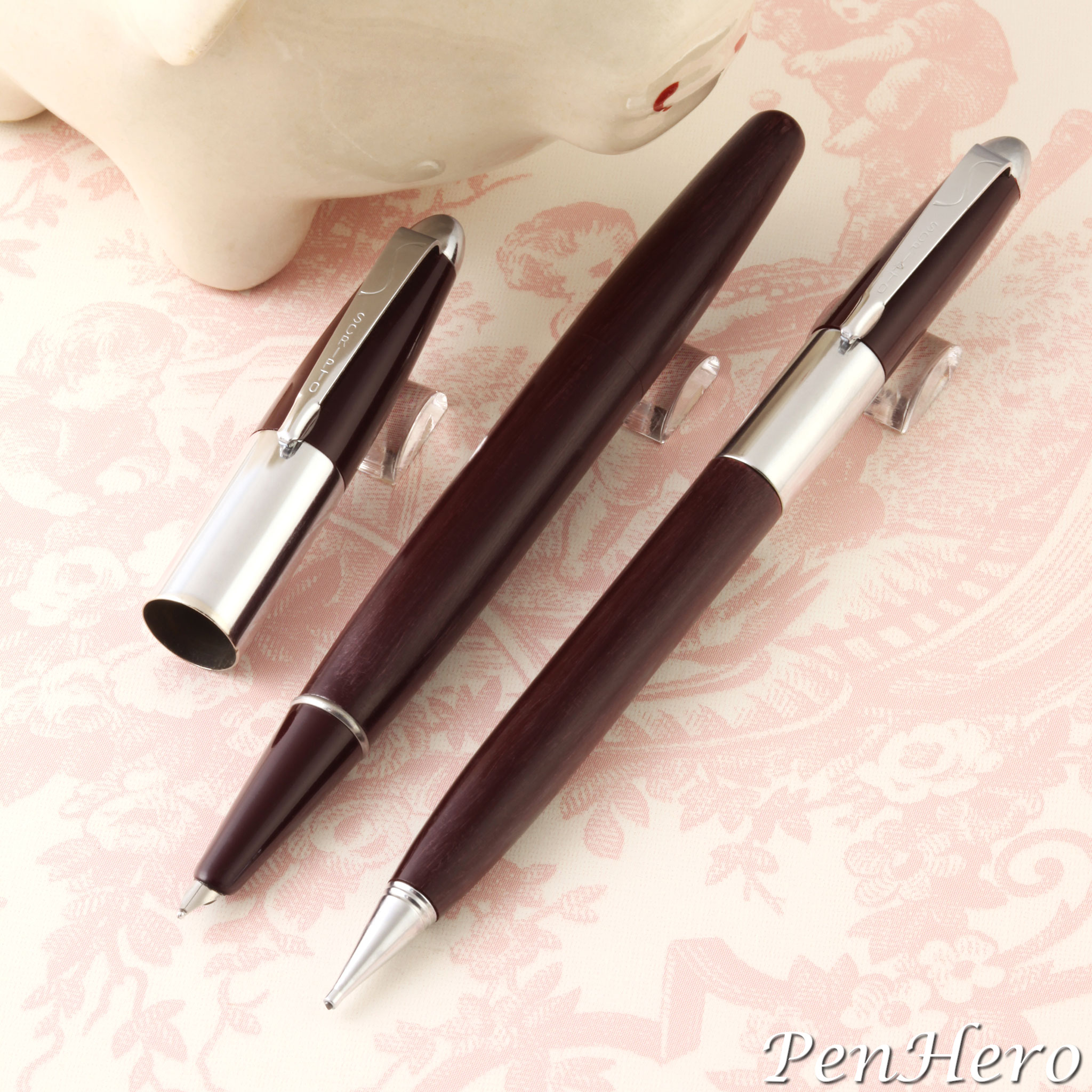 Scripto Long Writing Pen and Pencil Set in radiant dubonnet c. 1947-48
Scripto Long Writing Pen and Pencil Set in radiant dubonnet c. 1947-48
Shortly after Carmichael’s appointment, Scripto announced on May 11, 1947, its entry into the fountain pen market with its Walter Dorwin Teague designed Long Writing Pen. Teague was an American industrial designer and architect with a long relationship with Eastman Kodak, designing several cameras and also designed many other Art Deco styled products such as the Sparton Model 557 'Sled' Table Radio. The Long Writing Pen incorporates elements of “streamline moderne” with its curves and simple polished chrome plated appointments. The design clearly is influenced by the hooded nib trend started by the Parker with the 51 and also bears a resemblance to the Waterman Taperite Citation, introduced about a year earlier than Scripto's pen.
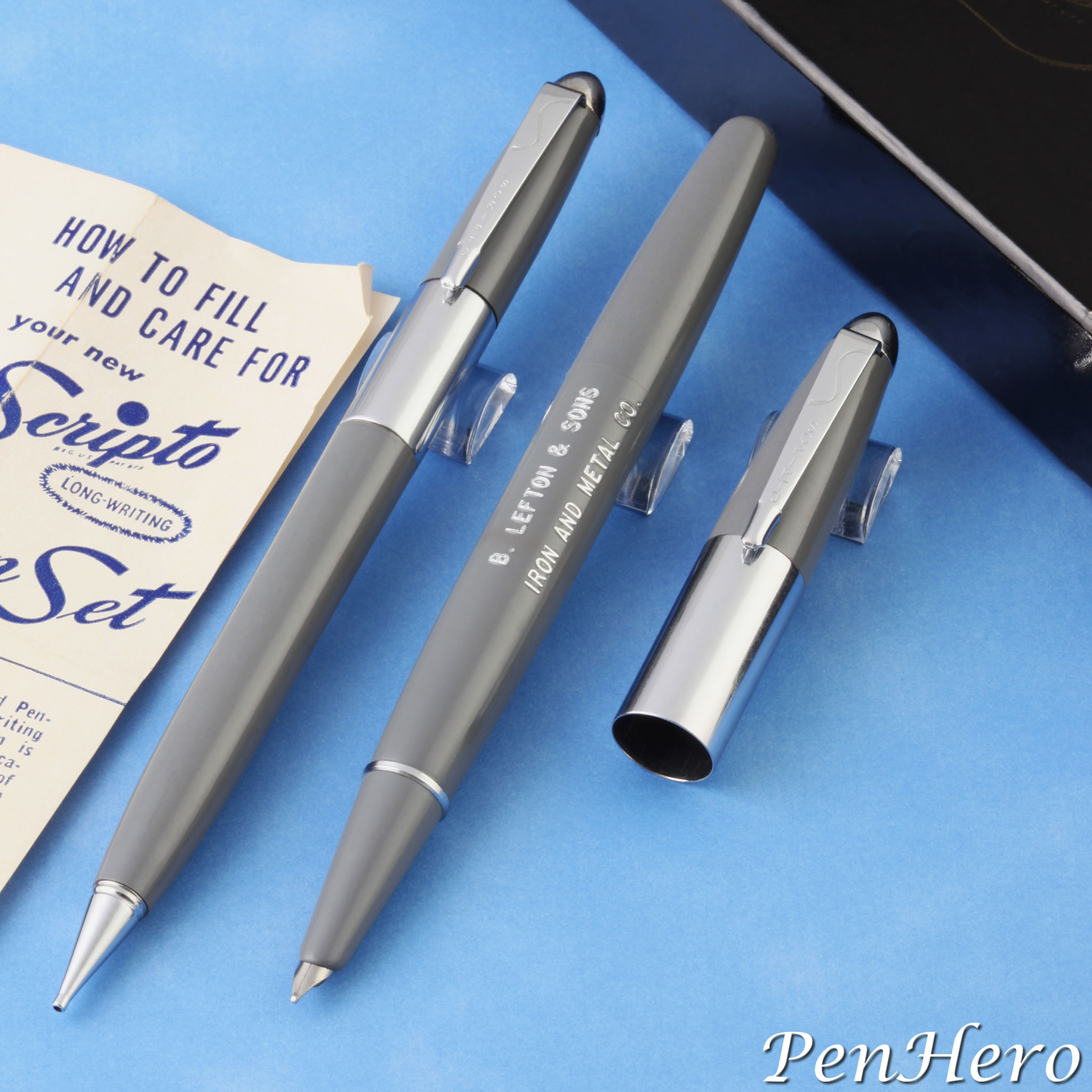 Scripto Long Writing Pen and Pencil Set in twilight gray c. 1947-48
Scripto Long Writing Pen and Pencil Set in twilight gray c. 1947-48
Although the Long Writing Pen has about the most generic name possible short of "fountain pen," Scripto trademarked "Solidium" for the point and "Magnifill" for the bulb filling system in 1947. These are good marketing at best. Solidium is likely standard “iridium” tipping and reveals nothing special about the tipping material any more than other such brandings. The Magnifill filling system is essentially a fancy brand name for a standard bulb filler that has a short breather tube in the feed to regulate air inside the ink sac and where the ink is stored directly in the barrel. Scripto proclaimed this simple system an advantage where the pen holds twice the ink as other, read: ink sac pens, and is so simple to use a “child or a genius” can fill it.
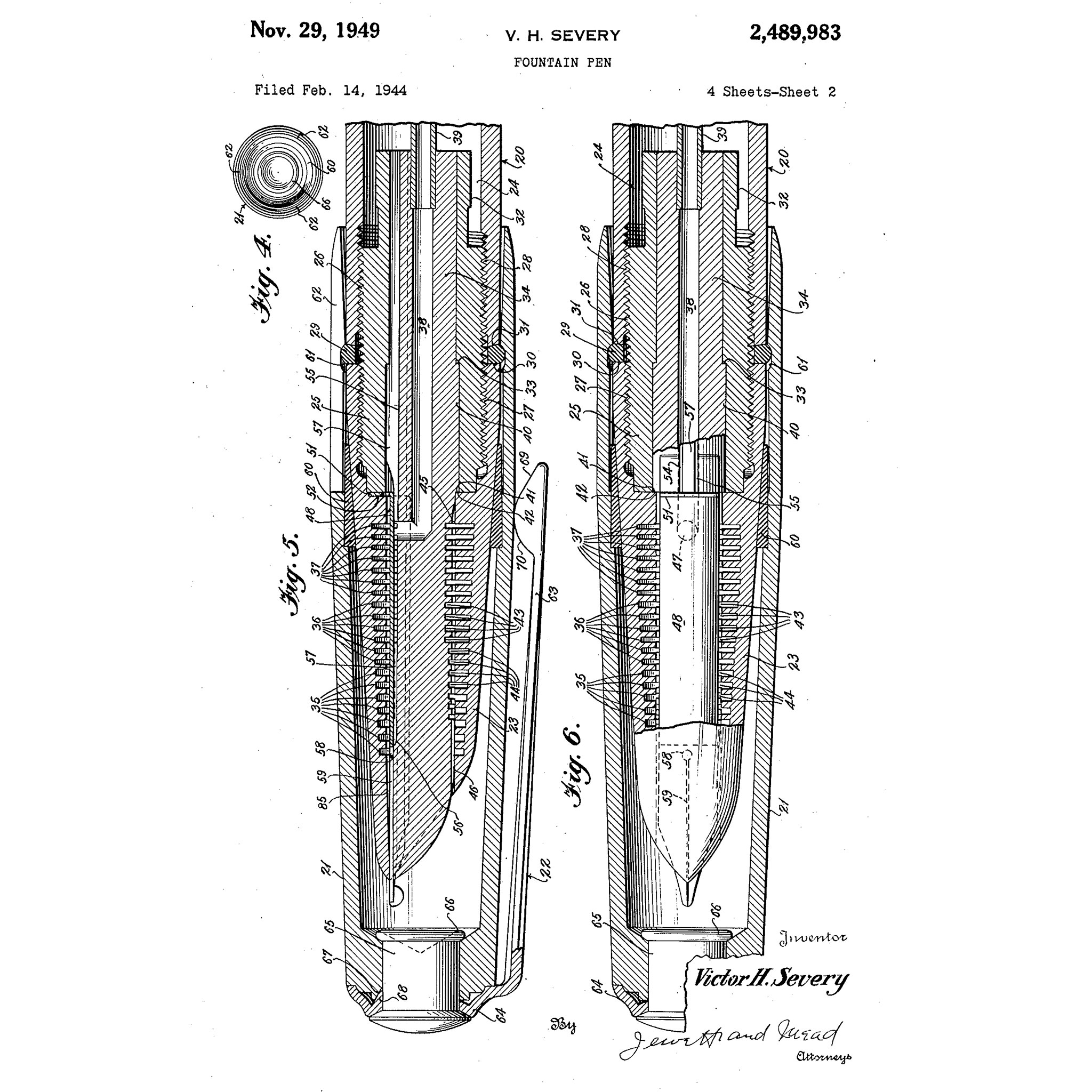 U. S. Patent 2,489,983 by Victor H. Severy, awarded November 29, 1949
U. S. Patent 2,489,983 by Victor H. Severy, awarded November 29, 1949
Scripto evidently was considering manufacturing fountain pens as early as 1944 given two patents awarded primarily for hooded nib and feed designs obviously inspired by the market leading Parker 51. This clearly shows that the impact of the Parker 51 was so large that it compelled a company not previously in the fountain pen market to go as far as designing and patenting a similar product and catch the wave. U. S. Patent 2,489,983 by Victor H. Severy, filed February 14, 1944, and awarded November 29, 1949, shows a hooded nib and feed distinctly similar to a Parker 51 and looks to me as if it may be some reverse engineering. The claim in this patent was for a hooded nib shell that has “annular capillary slots” on the inner surface and a closely fitting feed also with a longitudinal capillary passage placing said slots in communication.” The feed also has a vent tube at the end.
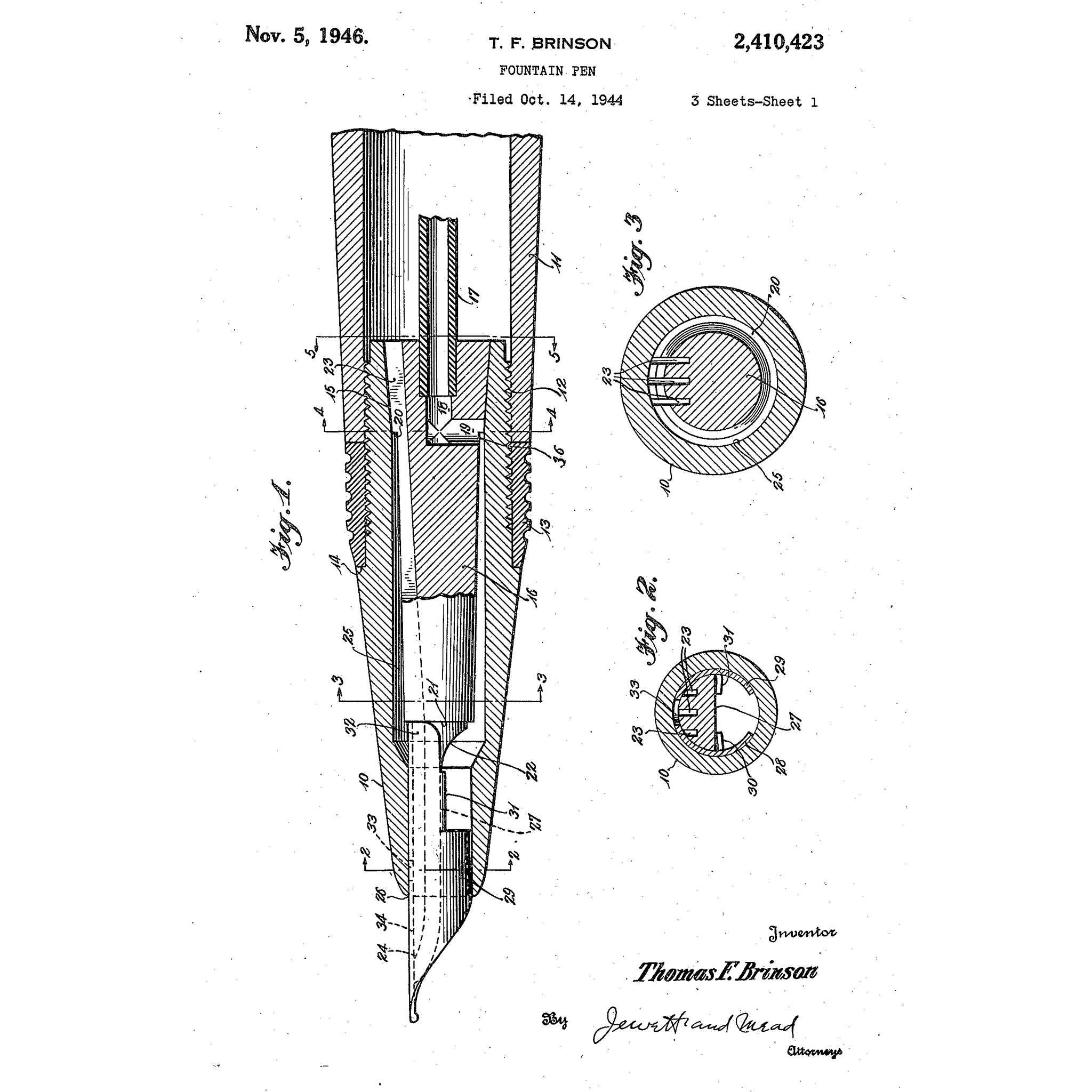 U. S. Patent 2,410,423 by Thomas F. Brinson, awarded November 5, 1949
U. S. Patent 2,410,423 by Thomas F. Brinson, awarded November 5, 1949
U. S. Patent 2,410,423 by Thomas F. Brinson filed October 14, 1944, and awarded November 5, 1949, describes improvements to the complete nib, feed and section design to provide storage for excess ink in the feed and to prevent blotting. The feed is much simpler than in the other patent and uses only ink channels, though three of them, and a breather tube with a cross bore to allow air flow into the ink reservoir. This patent appears to relate more to the later Scripto Worth-more fountain pen, which was advertised as having a “reserve” of ink, which likely meant the feed kept a little stash of ink that allowed the pen to keep writing if the ink sac was empty, though I have not had one to take apart and see if it matches the patent in any way.
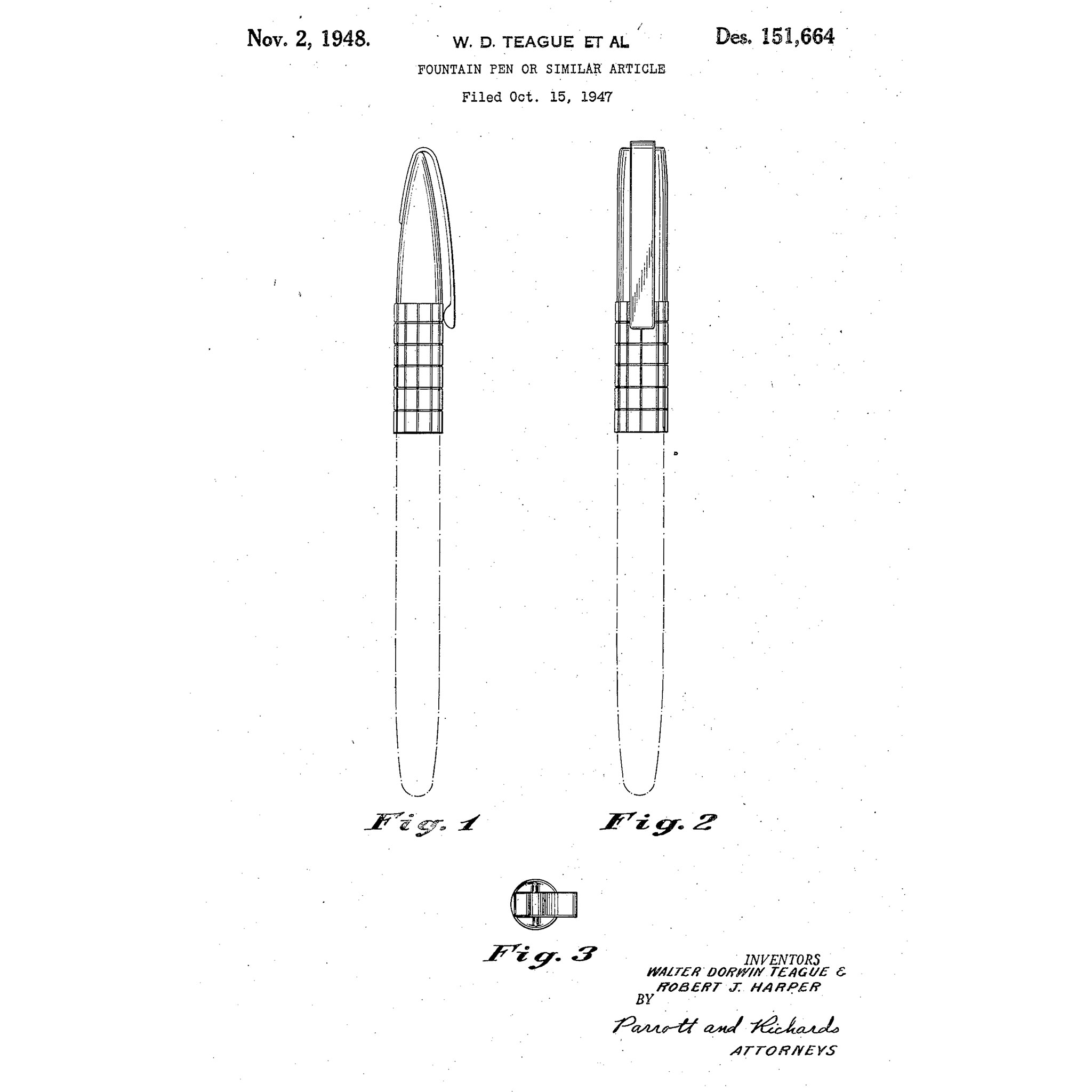 U. S. Design Patent 151,664 by Walter Dorwin Teague, awarded November 2, 1948
U. S. Design Patent 151,664 by Walter Dorwin Teague, awarded November 2, 1948
Interestingly, Walter Dorwin Teague was awarded two design patents assigned to Scripto that show that the company was possibly thinking of a next step or new model. Both show the same overall pen profile but new cap designs. Design patent 151,664 was applied for on October 15, 1947, and awarded November 2, 1948, and shows a long over the top rectangular military type clip. The cap band appears to be similar in width to the production pen but has an ornamental engraved square crosshatch design. Design patent 151,665 was applied for on October 16, 1947, and awarded November 2, 1948, is essentially the same except the cap band has alternating polished and brushed bands. There is no evidence that either of these designs were produced and no prototypes are known to exist.
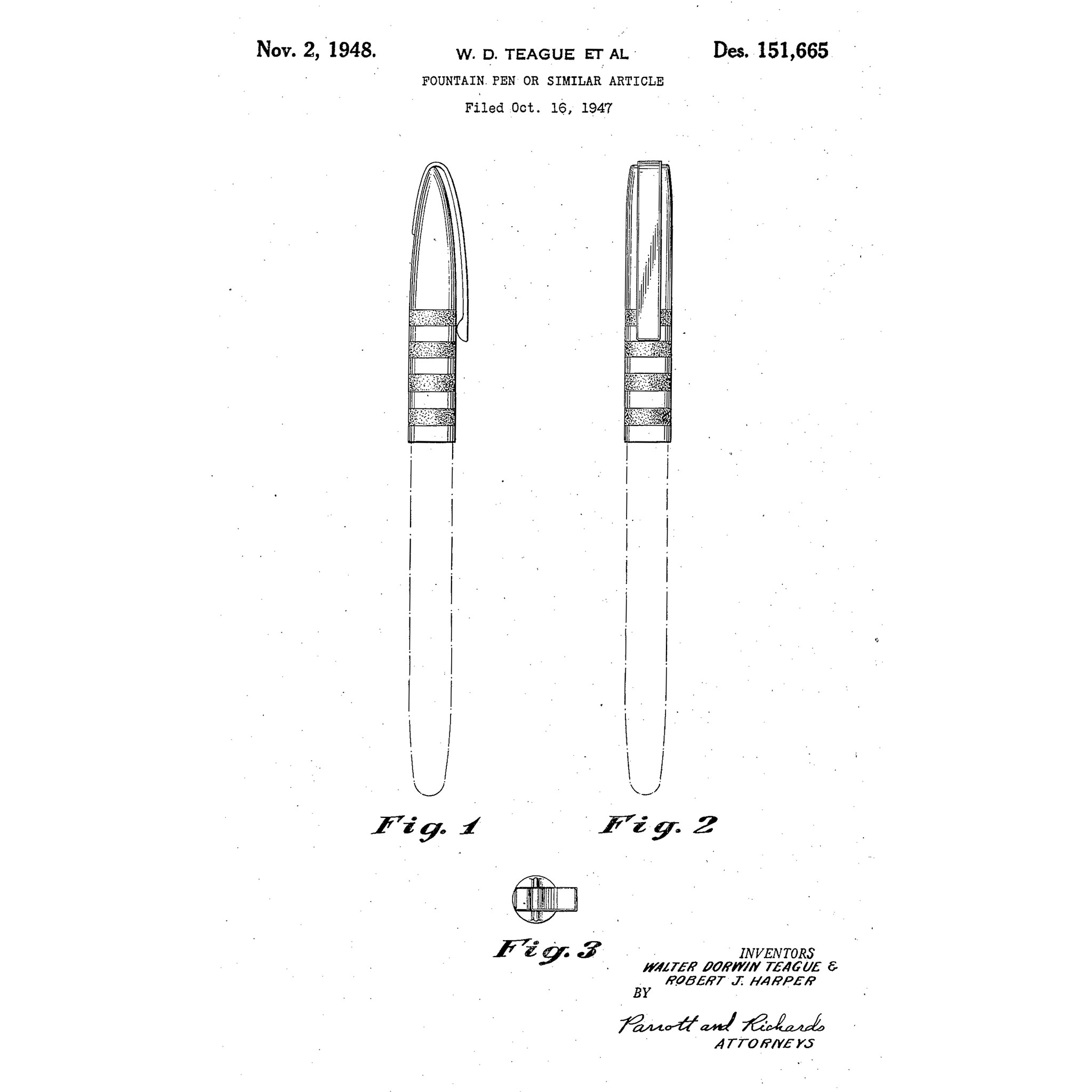 U. S. Design Patent 151,665 by Walter Dorwin Teague, awarded November 2, 1948
U. S. Design Patent 151,665 by Walter Dorwin Teague, awarded November 2, 1948
The Scripto Long Writing Pen was fairly widely advertised in 1947 but disappears before the end of 1948. The company appeared to focus on introducing ballpoint pens in 1949. In 1950 the hooded nib Worth-more fountain pen was introduced, an inexpensive lever-fill pen priced at much lower $1.00, indicating an ironically short life for the Long Writing Pen line and change of direction for the company.
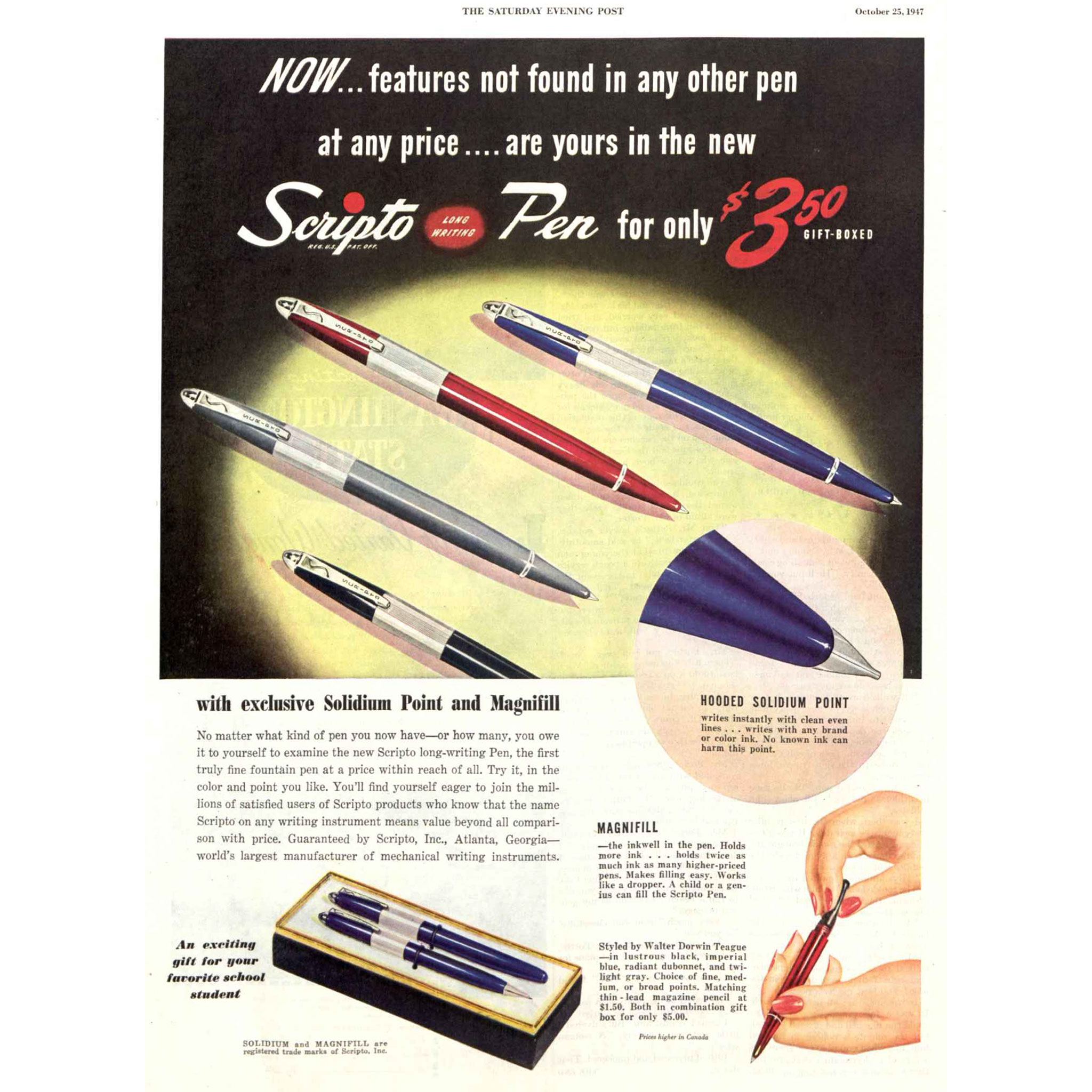 Scripto Advertisement, The Saturday Evening Post, October 25, 1947, page 166
Scripto Advertisement, The Saturday Evening Post, October 25, 1947, page 166
Identification Guide and Features
The Scripto Long Writing pen is a bulb filler with a breather tube that came in four molded plastic colors with chrome plated trim. The only references I could find on these pens are company advertisements, newspaper articles, and instruction sheets, aside from the pens themselves. These were used to create the guide below.
- Molded plastic cap and barrel
- Advertised colors are lustrous black, imperial blue, radiant dubonnet, and twilight gray
- Chrome plated clip and trim
- Plain cap band
- Scripto and S stamped clip
- Cap pulls off
- Hooded "solidium" point nib, probably stainless steel
- Advertised nib grades include fine, medium, and broad
- About 5 1/8 inches long capped
- Bulb-filling mechanism
- Fountain pen was priced $3.50 and matching twist-action pencils were $1.50
- Sold in paperboard boxes
Performance
As you would expect, this is an easy pen to fill. Unscrew the cap, stick the nib in ink, squeeze the bulb several times and you are ready to go. The pen is long enough to write without posting the cap on the end of the barrel, but the cap will stay put if posted. I do notice on the examples I have that the metal edge of the cap band can scuff up the barrel end if posted sloppily. The black one shown in this article writes a nice even line with a pencil like feel. I tried others and all of them seem to be this way.
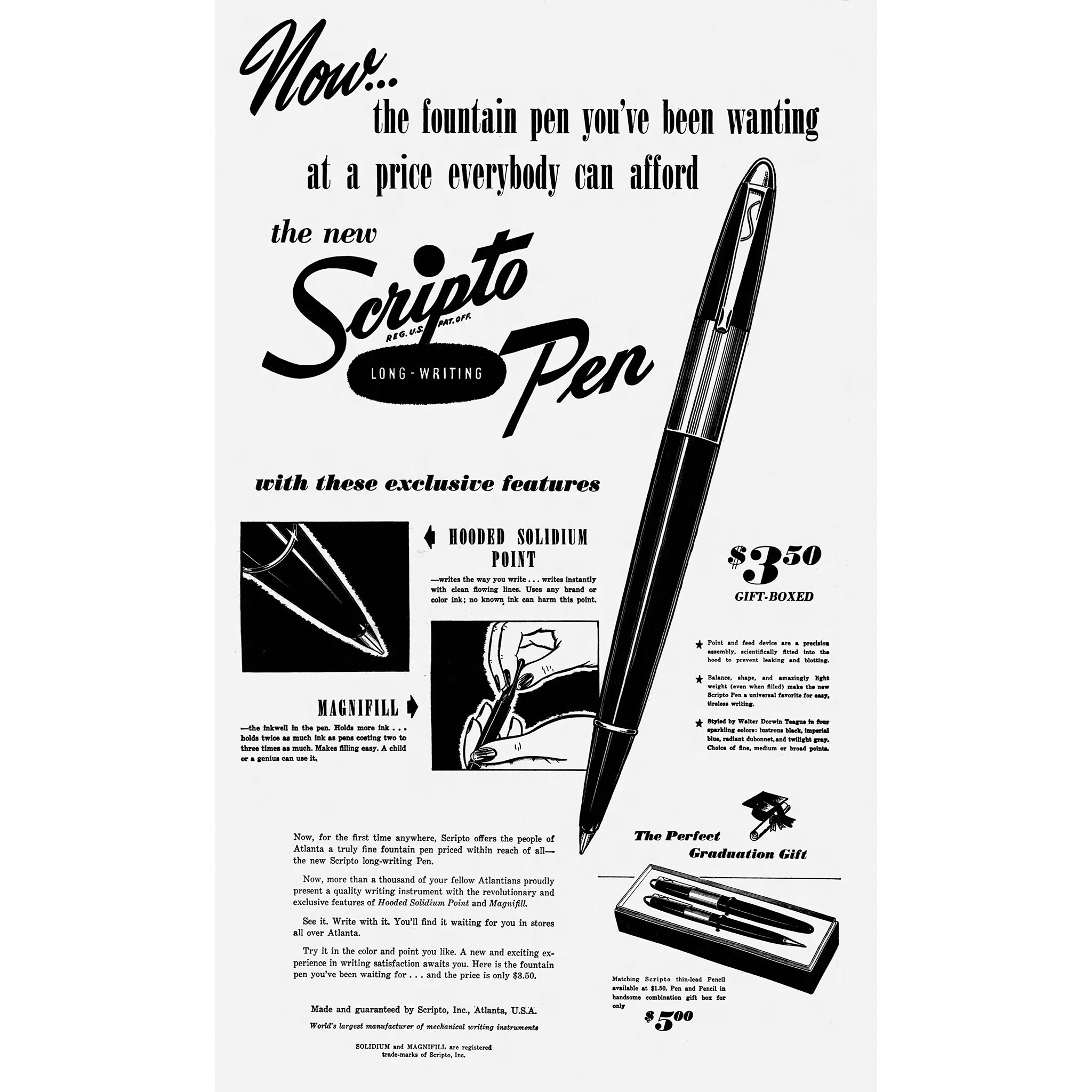 Scripto Advertisement, The Atlanta Constitution, May 18 1947, page 4B
Scripto Advertisement, The Atlanta Constitution, May 18 1947, page 4B
The fit and finish is consistent and well done. though there is the possibility of cap spin on one example I tried if the push on cap is pushed on too far. The clip is springy enough to pocket the pen securely on a flannel shirt.
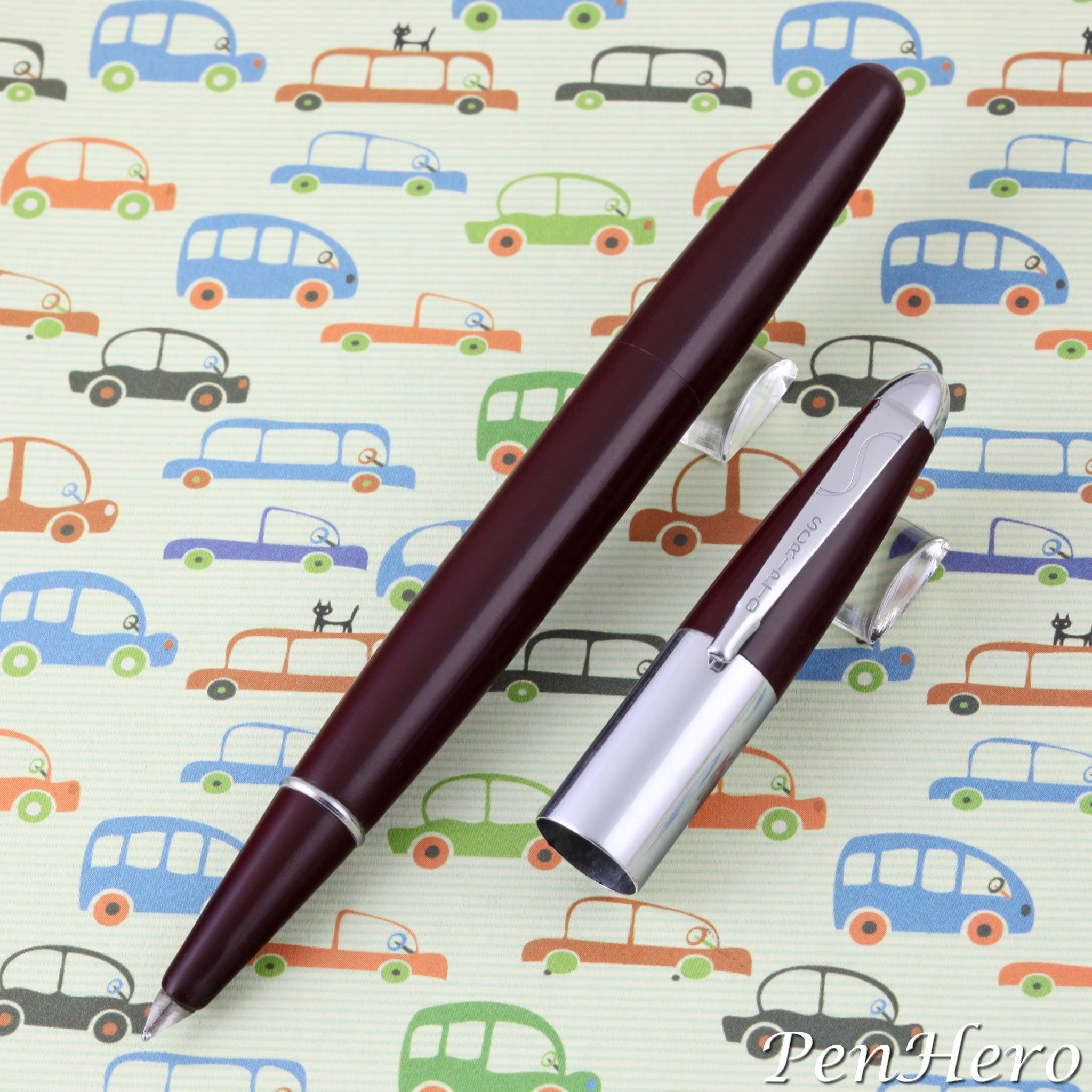 Scripto Long Writing Pen in radiant dubonnet c. 1947-48
Scripto Long Writing Pen in radiant dubonnet c. 1947-48
Overall, these are interesting pens for what they represent, a first effort by Scripto to enter the fountain pen market. The streamlined design would be at home in Flash Gordon's pocket, and it stands out from the many pens it would compete with at its price point. At lot of effort was put into this pen from design, patents, and marketing and yet for some reason it did not catch on with the public and appears to have been retired after only a year or two. Scripto quickly rolled out a new ballpoint pen in 1948 and the Long Writing Pen became the long gone pen.
They apparently weren't treasured by the original owners as they don't show up for sale very often. Acquiring one could lead to a very simple restoration if it only needs replacing the ink sac, which goes on the end of the barrel. There are only four colors known, and blue seems to be the hardest to find. When they do turn up, they are generally inexpensive. I found the ones I have interesting to learn about and decent writers.
References
"15 Seniors Tour Scripto Plant" The Atlanta Constitution, May 13, 1947, page 10
"Carmichael New Head Of Scripto Company" The Atlanta Constitution, April 27, 1947, page 4B
"New Ball Pen Offered by Scripto, Inc." The Atlanta Constitution, September 12, 1948, page 5D
Scripto Advertisement, The Atlanta Constitution, May 18 1947, page 4B
Scripto Advertisement, The Saturday Evening Post, March 20, 1948, page 80
Scripto Advertisement, The Saturday Evening Post, October 25, 1947, page 166
"Scripto Enters Fountain Pen Field" The Atlanta Constitution, May 11, 1947, page 14A
"Scripto Sales Volume Largest In Firm's History" The Atlanta Constitution, November 30, 1947, page 17C
U. S. Design Patent 151,664 by Walter Dorwin Teague, filed October 15, 1947, and awarded November 2, 1948
U. S. Design Patent 151,665 by Walter Dorwin Teague, filed October 16, 1947, and awarded November 2, 1948
U. S. Patent 2,410,423 by Thomas F. Brinson, filed October 14, 1944, and awarded November 5, 1949
U. S. Patent 2,489,983 by Victor H. Severy, filed February 14, 1944, and awarded November 29, 1949
"U. S. Possibilities 'Tops,' Says Industrial Designer" The Atlanta Constitution, May 15, 1947, page 4
U. S. Trademark 516,151, "SOLIDIUM" for pen points, Scripto, Inc., Atlanta, Georgia, filed January 22, 1947, claimed use since November 27, 1946
U. S. Trademark 516,444, "MAGNIFILL" for writing pens, Scripto, Inc., Atlanta, Georgia, filed January 27, 1947, claimed use since January 10, 1947
Interact
Comments on this article may be sent to the author, Jim Mamoulides


